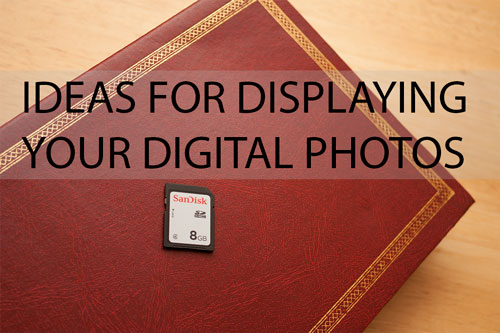Ideas For Displaying Your Digital Photos
Before the days of digital photography, photos would (virtually) always be printed. There wasn't really any other way of viewing the images, unless you liked looking at the tiny negatives!
But in this digital age, the vast majority of photos are never printed. They sit languishing on hard drives, unlikely to be looked at again. So, what can you do about making sure your photos actually get seen?
Online sharing
The most popular solution is sharing photos online, for example through Facebook. This allows your photos to be seen by a large a number people easily. It is also pretty easy to display your photos this way, no waiting for prints, and no cost.
However, there are a couple of negatives about this method. After you first share your photos, they quickly get buried below the constant stream of other photos, status updates etc. coming in. How often do you go back and look and photos you posted a while ago online? Not very often I suspect.
The other issue is that sharing online might not reach all the people who you want to see your photo. If sharing on Facebook, what about your friends or relatives that don't have a Facebook account? Or elderly relatives that don't know how to use the internet?
Displaying Your Photos As Prints
While most people don't get their photos printed nowadays, there's nothing to stop you from doing so. In fact there are quite a few services now offering digital prints and enlargements for much less than the cost you used to pay for film development and prints.
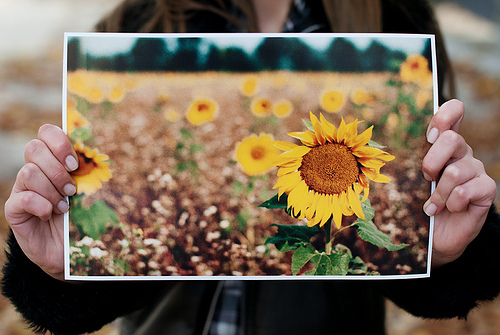
It's a sunflower 'give away' time. by Iryna Yeroshko on flickr (licensed CC-BY)
A large print on your wall will definitely get seen, at least by you. Depending on which room you place it in, you can make sure it gets seen by visitors too. While a print on the wall is likely to get seen much more often than one uploaded to the web, it will also be seen by far fewer people. An exception to this might be if the wall the print is displayed on is in a public space. But for most of us, that's probably not an option.
One of the good things about prints is that there are lots of options available to you. Different sizes, and endless framing options. Different papers, or even different materials such as canvas prints and metal prints.
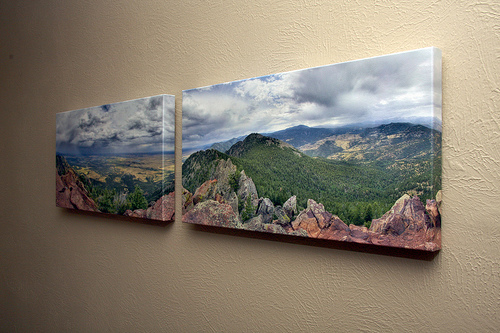
Canvas panorama by Andrew Magill on flickr (licensed CC-BY)
The main disadvantage to having your photos printed is the cost. The second disadvantage is the space they take up. You probably have several thousand photos you can easily view on your computer. You can have new photos printed, and replace the old ones, but what are you going to do with those old prints? It would be a waste to just throw them away.

Prints of our past summer by Desi on flickr (licensed CC-BY)
You could go in for just getting standard sized prints, and then putting them into albums. But then you're left with a similar situation to having the images on a computer - how often will you actually look back through those albums? Albums can be a good way of showing images to family or friends when they come over, but there are better solutions in my opinion (see next).
Using A Projector To Display Your Photos
It's unlikely you'd want to display your digital photos via projector as a standard means of displaying your photos. However, it can be a very good way of sharing images when you have people over. It allows everyone in the room to see the same image at the same time, you can explain the image, and your guests can ask questions about the image.
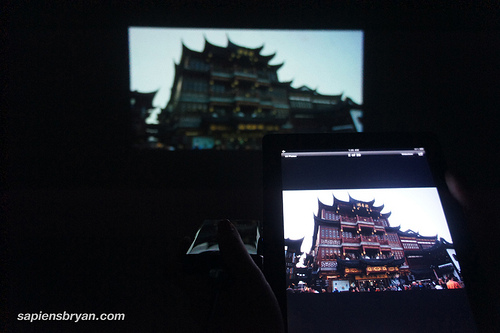
Viewing picture slideshow On iPad via the projector by SapiensBryan on flickr (licensed CC-BY-ND)
The cost of a digital projector isn't too bad compared to what slide projectors used to cost (of course 2nd hand slide ones can be had fairly cheaply now). Just as using a slide projector was a good way to share your images with a small group of people in the times of film photography, so using a digital projector is today. But the initial cost is definitely higher than most other methods of displaying your photos.
One issue with a projector is that it needs setting up. It's not particularly portable, and you can't use it to quickly show someone one of your photos like you can with other display methods. You can buy small projectors, but they tend to be lacking in quality or quite expensive. You will also need a blank wall in a darkened area to display the images on either way.
Use Your Photos As A Screensaver Or Desktop Background
A good way of displaying photos to yourself is to set your screensaver or desktop background to display a slideshow of one of your image folders. This way whenever you're using (or stop using for a few minutes in the case of a screensaver) your computer, you'll get to see your photos.
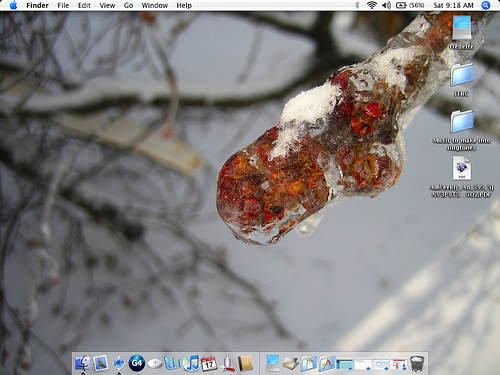
iBook desktop by Tony Unruh on flickr (licensed CC-BY-ND)
It may seem a bit narcissistic to have your own photos displaying as your Desktop or Screensaver. But really, it's better than having your photos sit around unseen. There's nothing wrong with viewing or liking your own photos!
Display Your Photos On TV
Many modern TVs have the ability to display a slideshow of images, and feature a USB socket that you can insert a USB memory stick into. So it's just a case of copying your photos to the a memory stick, inserting it into the TV, then starting the slideshow. Like a projector, this can be a good method of displaying images when you have people over, or even when you're visiting someone else's home.
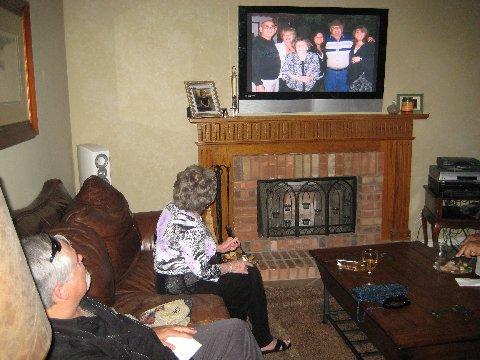
watching the slide show by Christine Olson on flickr (licensed CC-BY-ND)
Digital Photo Frame
Digital Photo Frames are widely available, and their cost has decreased substantially since when they were first introduced. Most frames have built-in memory that you can use to store images and also feature an SD or micro SD card slot that you can use to expand the frame's capacity.
The benefit of a digital photo frame is that you can show a slideshow of images in a single frame, no need for separate frames for each image you want to display.
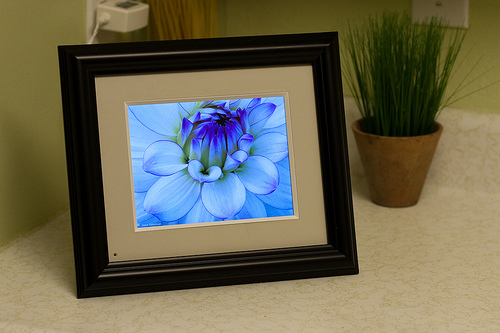
Digital Picture by sean hobson on flickr (licensed CC-BY)
However, they do have several disadvantages. Most digital photo frames are mains powered, meaning you need to locate them near a power socket. You may find the trailing power wire unsightly. While battery powered frames are available, typically the battery will only last for around 8 hours or so. Either way you end up spending more on electricity.
Not specifically a failing of digital photo frames, but something to bear in mind, is that the images you load onto the frame should all be the same orientation. If you mix up portrait and landscape orientated images, then one or the other is only going to display very small (or maybe sideways), depending on the orientation of the frame.
Another issue with digital photo frames is their size-cost ratio. With larger frame sizes, the price increases significantly. Seven inch frames can be had fairly cheaply, but the cheapest are often low resolution. They may look fine sitting on your mantelpiece, but if you pick the frame up for a closer look, the image won't be as good as a printed photograph.
Show Off Your Photos On Your Smartphone
Yes, you can use your phone for displaying images. While it's unlikely you'd want to set your phone displaying a slideshow and then put it on the wall, it can be a good way of quickly showing images to another person. It's a bit like having photos of your family in your wallet, except that you can have many photos, and display them quite a bit larger than the typical wallet photo.
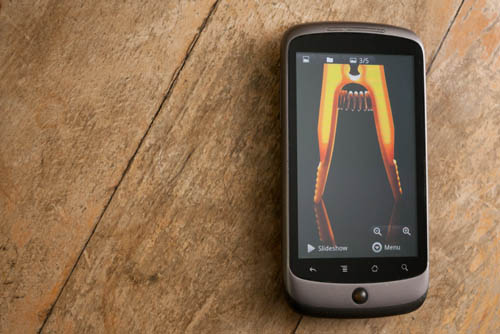
Phone memory is typically more of an issue than with other devices, so it is a good idea to resize down any images you want to display on your phone before copying them to the device. It can be a great way to let someone have a quick look at your photography portfolio.
Of course, the obvious issue with a phone is the small size, and only one or two people can really see the screen at once. Like some of the other display methods, it's also a temporary display rather than a permanent one.
Get A Photo Book Printed
Have you ever purchased a coffee table book by another photographer (or collection of photographers)? What about making your own? There are quite a few different services that you can use to create your own photo book.

Blurb Book by Lorna Mitchell on flickr (licensed CC-BY-ND)
In my opinion photo books are a very nice way of displaying photos. There's a definite difference between viewing a projected image from a screen and a reflected image from printed matter.
However, there is a big disadvantage to photo books - the price. Because they are produced in such small quantities (often just a single copy), photo books tend to be very expensive. Unfortunately there's no getting round this, unless you can successfully run a Kickstarter campaign to get a good number of books printed. (If you have a good following as a photographer, a Kickstarter campaign may be a real option for you).
Create Your Own Photography E-Book
On the other hand, how about creating a photo book, but then not getting it printed? The book can be distributed digitally. But why would you do this over just sharing the individual photos?
Putting photos together in a book can create a story that links the photos together, so that the book becomes more than the sum of the parts. This is an important point, the photos need to tie together some way, rather than just being a random collection of photos. Looking at other photo books can be helpful to give you some inspiration.
Boring by Jay Komuda, a great example of a photography e-book.
For creating an e-book (and print book for that matter), there are various software packages you can use. But it is worth mentioning that Lightroom, which many photographers already use, contains within it a book module. While not quite as fully-featured as proper DTP program, the book module can be used for professional results without too much difficulty.
Create A Calendar
Producing a calendar featuring your photography can be a good way to display your photos year round. Changing the image each month keeps the photo on display relatively fresh.
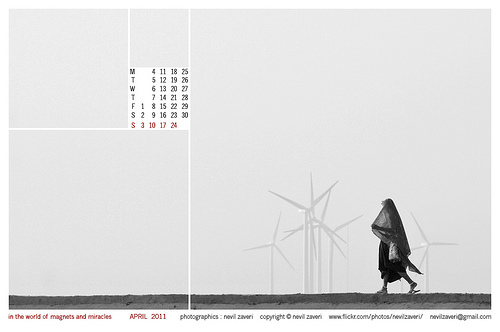
in the world of magnets and miracles - wallpaper calendar for april 2011 by nevil zaveri on flickr (licensed CC-BY)
A photo calendar can also make a good Christmas gift for family and friends. (It's a bit late for calendar creation at the time of writing, but you can think about it for next year's calendar).
Custom Business Cards
Having a set of business cards produced with a variety of your photos can be a nice way to show off your images to people you meet. There are a few providers that can print business cards where each one has a different image, Moo being probably the most well known.
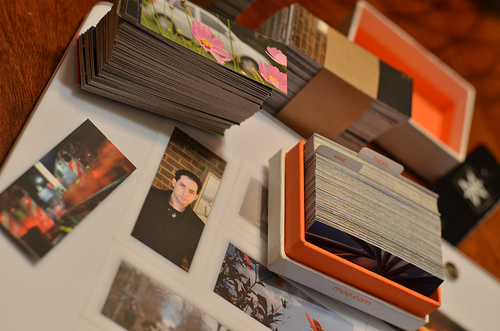
Artist Business Cards by Michael Kappel on flickr (licensed CC-BY-ND)
It can be quite funny when you give someone a business card with one of your photos printed on it and they ask Can I really keep it?
It's a good way to show the type of photography you enjoy, as well as having a business card that will stand out.
So, which is the best method for displaying digital photos? As you may have guessed, the answer is not one single method, but to use a combination. You might have some prints on your walls, share photos regularly online, and keep some photos on your phone for showing people you meet. Then you might occasionally use a projector or TV for showing a slideshow of photos to family or friends, for example showing photos from a holiday.
I hope this article has given you some ideas about displaying your photos. It's a shame to take lots of photos but not have anyone see them. Enjoy taking photos, but don't forget to enjoy viewing them as well!
What's your favorite way to display your photos? Do you have any other suggestions for displaying photos?
